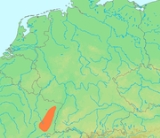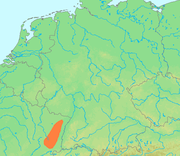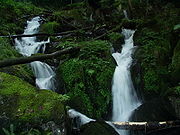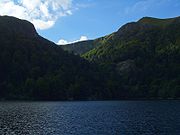
Vosges mountains
Encyclopedia




Vosges
Vosges is a French department, named after the local mountain range. It contains the hometown of Joan of Arc, Domrémy.-History:The Vosges department is one of the original 83 departments of France, created on February 9, 1790 during the French Revolution. It was made of territories that had been...
.
The Vosges (voːʒ) (German: Vogesen, foˈgeːzn̩) are a range of low mountain
Mountain
Image:Himalaya_annotated.jpg|thumb|right|The Himalayan mountain range with Mount Everestrect 58 14 160 49 Chomo Lonzorect 200 28 335 52 Makalurect 378 24 566 45 Mount Everestrect 188 581 920 656 Tibetan Plateaurect 250 406 340 427 Rong River...
s in eastern France
France
The French Republic , The French Republic , The French Republic , (commonly known as France , is a unitary semi-presidential republic in Western Europe with several overseas territories and islands located on other continents and in the Indian, Pacific, and Atlantic oceans. Metropolitan France...
, near its border with Germany
Germany
Germany , officially the Federal Republic of Germany , is a federal parliamentary republic in Europe. The country consists of 16 states while the capital and largest city is Berlin. Germany covers an area of 357,021 km2 and has a largely temperate seasonal climate...
. They extend along the west side of the Rhine valley in a northnortheast direction, mainly from Belfort
Belfort
Belfort is a commune in the Territoire de Belfort department in Franche-Comté in northeastern France and is the prefecture of the department. It is located on the Savoureuse, on the strategically important natural route between the Rhine and the Rhône – the Belfort Gap or Burgundian Gate .-...
to Saverne
Saverne
Saverne is a commune in the Bas-Rhin department in Alsace in north-eastern France. It is situated on the Rhine-Marne canal at the foot of a pass over the Vosges Mountains, and 45 km N.W...
. The Grand Ballon
Grand Ballon
Le Grand Ballon is the apex of the Vosges Mountains, located 25 kilometres northwest of Mulhouse, France.Some still call it Ballon de Guebwiller, after the name of the closest city, Guebwiller, located 8 km to the east...
is the highest peak at 1424m.
Geography
The elongated massifMassif
In geology, a massif is a section of a planet's crust that is demarcated by faults or flexures. In the movement of the crust, a massif tends to retain its internal structure while being displaced as a whole...
is divided south to north into three sections:
- the Higher Vosges (Hautes Vosges), extending in the southern part of the range from Belfort to the valley of the BrucheBrucheBruche is a large suburb of Warrington, England.It forms the old border of Poulton and Warrington.As of 2005 it is home to the Bruche Police Training Centre, a national police training centre.- See also :...
. The rounded summits of the Hautes Vosges are called ballons in French or "balloons". - the sandstoned Vosges (50 km, or 31 miles), between the Permian Basin of Saint-Die including the Devon-Dinantian volcanic massif of Schirmeck-Moyenmoutier and the Col de Saverne
- the Lower Vosges (48 km, or 30 miles), between the Col de Saverne and the source of the LauterLauterLauter may refer to:In towns:*Lauter, Saxony, town in the district of Aue-Schwarzenberg, Saxony, Germany*Lauter, Bavaria, village in the district of Bamberg, Bavaria, GermanyIn rivers:*Lauter , tributary to the Baunach, Germany...
.
In addition, the term "Central Vosges" is used to designate the various lines of summits, especially those above 1000 metres in elevation. The French department of Vosges
Vosges
Vosges is a French department, named after the local mountain range. It contains the hometown of Joan of Arc, Domrémy.-History:The Vosges department is one of the original 83 departments of France, created on February 9, 1790 during the French Revolution. It was made of territories that had been...
is named after the range.
From a geological
Geology
Geology is the science comprising the study of solid Earth, the rocks of which it is composed, and the processes by which it evolves. Geology gives insight into the history of the Earth, as it provides the primary evidence for plate tectonics, the evolutionary history of life, and past climates...
point of view, a graben
Graben
In geology, a graben is a depressed block of land bordered by parallel faults. Graben is German for ditch. Graben is used for both the singular and plural....
in the beginning of the Tertiary
Tertiary
The Tertiary is a deprecated term for a geologic period 65 million to 2.6 million years ago. The Tertiary covered the time span between the superseded Secondary period and the Quaternary...
area caused the formation of Alsace
Alsace
Alsace is the fifth-smallest of the 27 regions of France in land area , and the smallest in metropolitan France. It is also the seventh-most densely populated region in France and third most densely populated region in metropolitan France, with ca. 220 inhabitants per km²...
and the uplift of the plates of the Vosges now in eastern France
France
The French Republic , The French Republic , The French Republic , (commonly known as France , is a unitary semi-presidential republic in Western Europe with several overseas territories and islands located on other continents and in the Indian, Pacific, and Atlantic oceans. Metropolitan France...
and the Black Forest
Black Forest
The Black Forest is a wooded mountain range in Baden-Württemberg, southwestern Germany. It is bordered by the Rhine valley to the west and south. The highest peak is the Feldberg with an elevation of 1,493 metres ....
now in Germany. Strictly speaking scientifically, the Vosges Mountains are not mountains as such, but rather the western edge of the unfinished Alsatian graben, stretching continuously as part of the larger Tertiary formations. Erosive glacial action was the primary means by which the representative highland
Highland (geography)
The term highland or upland is used to denote any mountainous region or elevated mountainous plateau. Generally speaking, the term upland tends to be used for ranges of hills, typically up to 500-600m, and highland for ranges of low mountains.The Scottish Highlands refers to the mountainous...
massif feature developed.
Geographically
Geography
Geography is the science that studies the lands, features, inhabitants, and phenomena of Earth. A literal translation would be "to describe or write about the Earth". The first person to use the word "geography" was Eratosthenes...
, the Vosges Mountains are located wholly in France
France
The French Republic , The French Republic , The French Republic , (commonly known as France , is a unitary semi-presidential republic in Western Europe with several overseas territories and islands located on other continents and in the Indian, Pacific, and Atlantic oceans. Metropolitan France...
far above the Col de Saverne
Col de Saverne
The Col de Saverne is a natural pass in the north of the Vosges mountains, near Saverne, which permits travel between the département of Bas-Rhin, région Alsace and the département of Moselle, région Lorraine.Lines of communication that traverse the Saverne Pass include national highway RN 4 and...
separating them from the Palatinate Forest in Germany, which logically continues the same Vosges geologic structure but traditionally receives this different name for historical and political reasons.
The Vosges in their southern and central parts are called the Hautes Vosges. These consist of a large Carboniferous
Carboniferous
The Carboniferous is a geologic period and system that extends from the end of the Devonian Period, about 359.2 ± 2.5 Mya , to the beginning of the Permian Period, about 299.0 ± 0.8 Mya . The name is derived from the Latin word for coal, carbo. Carboniferous means "coal-bearing"...
mountain eroded just before the Permian
Permian
The PermianThe term "Permian" was introduced into geology in 1841 by Sir Sir R. I. Murchison, president of the Geological Society of London, who identified typical strata in extensive Russian explorations undertaken with Edouard de Verneuil; Murchison asserted in 1841 that he named his "Permian...
era with gneiss
Gneiss
Gneiss is a common and widely distributed type of rock formed by high-grade regional metamorphic processes from pre-existing formations that were originally either igneous or sedimentary rocks.-Etymology:...
, granite
Granite
Granite is a common and widely occurring type of intrusive, felsic, igneous rock. Granite usually has a medium- to coarse-grained texture. Occasionally some individual crystals are larger than the groundmass, in which case the texture is known as porphyritic. A granitic rock with a porphyritic...
s, porphyritic
Porphyritic
Porphyritic is an adjective used in geology, specifically for igneous rocks, for a rock that has a distinct difference in the size of the crystals, with at least one group of crystals obviously larger than another group...
masses or other volcanic intrusions. but in the north, south and west, there places less eroded by glaciers, and here Vosges Triassic
Triassic
The Triassic is a geologic period and system that extends from about 250 to 200 Mya . As the first period of the Mesozoic Era, the Triassic follows the Permian and is followed by the Jurassic. Both the start and end of the Triassic are marked by major extinction events...
and Permian red sandstone
Sandstone
Sandstone is a sedimentary rock composed mainly of sand-sized minerals or rock grains.Most sandstone is composed of quartz and/or feldspar because these are the most common minerals in the Earth's crust. Like sand, sandstone may be any colour, but the most common colours are tan, brown, yellow,...
remains in large beds. The grès vosgien, (a French name for a Triassic rose sandstone) are embedded sometimes up to more than 500 metres in thickness. The Lower Vosges in north are dislocated plates of various sandstones, ranging from 300 to 600 metres (1000 to 1850 ft.) high.
The highest points are located in the Hautes Vosges: the Grand Ballon
Grand Ballon
Le Grand Ballon is the apex of the Vosges Mountains, located 25 kilometres northwest of Mulhouse, France.Some still call it Ballon de Guebwiller, after the name of the closest city, Guebwiller, located 8 km to the east...
in ancient times called Ballon de Guebwiller or Ballon de Murbach rises to 1424 m (4,670 ft), the Storckenkopf to 1366 m (4,481 ft), the Hohneck to 1364 m (4,475 ft), and the Ballon d'Alsace
Ballon d'Alsace
Ballon d'Alsace is a mountain at the border of Alsace, Lorraine, and Franche-Comté. From its top, views include the Vosges, the Rhine valley, and the Black Forest.A road leads over a pass near the peak at ....
to 1247 m (4,091 ft). The Col de Saales, between the Higher and Central Vosges, reaches nearly 579 m (1,900 ft), both lower and narrower than the Higher Vosges, with Mont Donon
Mont Donon
Mont Donon is the highest peak in the northern Vosges. It is a Category 2 climb in the Tour de France.On Donon, there is a 80 metre tall lattice tower for TV transmission...
(1008 m, 3307 ft.) being the highest point of this Nordic section.
There is a remarkable similarity between the Vosges and the corresponding range of the Black Forest
Black Forest
The Black Forest is a wooded mountain range in Baden-Württemberg, southwestern Germany. It is bordered by the Rhine valley to the west and south. The highest peak is the Feldberg with an elevation of 1,493 metres ....
on the other side of the Rhine: both lie within the same degrees of latitude, have similar geological formations and are characterized by forests on their lower slopes, above which are open pastures and rounded summits of a rather uniform altitude; furthermore, both exhibit steeper slopes towards the Rhine and a more gradual descent on the other side. This occurs because both the Vosges and the Black Forest were formed by isostatic uplift, in a response to the opening of the Rhine Graben. The Rhine Graben is a major extensional basin. When such basins form, the thinning of the crust causes uplift immediately adjacent to the basin. The amount of uplift decreases with distance from the basin, causing the highest range of peaks to be immediately adjacent to the basin, and the increasingly lower mountains to stretch away from the basin.
Climate
MeteorologicallyMeteorology
Meteorology is the interdisciplinary scientific study of the atmosphere. Studies in the field stretch back millennia, though significant progress in meteorology did not occur until the 18th century. The 19th century saw breakthroughs occur after observing networks developed across several countries...
, the difference between the eastern and western mean slopes of the range is very marked. The main air streams come generally from the west and south-west, so the Alsatian central plains just under the Hautes-Vosges receive much less water than the south-west front of the Vosges Mountains. The highlands of the arrondissement
Arrondissement
Arrondissement is any of various administrative divisions of France, certain other Francophone countries, and the Netherlands.-France:The 101 French departments are divided into 342 arrondissements, which may be translated into English as districts. The capital of an arrondissement is called a...
of Remiremont receive as annual rainfall or snowfall more than 2 metres of water yearly, whereas some dry country near Colmar receives less than 500 mm of water in the event of insufficient storms. The temperature is much lower in the west front of the mountains than in the low plains behind the massif, especially in summer. On the eastern slope economic vineyards reach to a height of 400 metres (1300 ft.); on the other hand, in the mountains, it is a land of pasture and forest.
The only river
River
A river is a natural watercourse, usually freshwater, flowing towards an ocean, a lake, a sea, or another river. In a few cases, a river simply flows into the ground or dries up completely before reaching another body of water. Small rivers may also be called by several other names, including...
s in Alsace are the Ill
Ill (France)
The Ill is a river in Alsace, in north-eastern France. It is a left-side, or western tributary of the Rhine.It starts down from its source near the village of Winkel, in the Jura mountains, with a resurgence near Ligsdorf, turns around Ferrette on its east side, and then runs northward through...
coming from south Alsace (or Sundgau), and the Bruche d'Andlau and the Bruche which have as tributaries other, shorter but sometimes powerful streams coming like the last two from the Vosges Mountains. The Moselle
Moselle River
The Moselle is a river flowing through France, Luxembourg, and Germany. It is a left tributary of the Rhine, joining the Rhine at Koblenz. A small part of Belgium is also drained by the Mosel through the Our....
, Meurthe
Meurthe River
The Meurthe is a river in north-eastern France, right tributary to the river Moselle. Its source is in the Vosges mountains, near the Col de la Schlucht in the Vosges département...
and Sarre
Saar River
The Saar is a river in northeastern France and western Germany, and a right tributary of the Moselle. It rises in the Vosges mountains on the border of Alsace and Lorraine and flows northwards into the Moselle near Trier. It has two headstreams , that both start near Mont Donon, the highest peak...
rivers and theirs numerous affluents all rise on the Lorraine
Lorraine (région)
Lorraine is one of the 27 régions of France. The administrative region has two cities of equal importance, Metz and Nancy. Metz is considered to be the official capital since that is where the regional parliament is situated...
side.
In the High Moselle and Meurthe basins, moraine
Moraine
A moraine is any glacially formed accumulation of unconsolidated glacial debris which can occur in currently glaciated and formerly glaciated regions, such as those areas acted upon by a past glacial maximum. This debris may have been plucked off a valley floor as a glacier advanced or it may have...
s, boulders and polished rocks testify to the existence of ancient glacier
Glacier
A glacier is a large persistent body of ice that forms where the accumulation of snow exceeds its ablation over many years, often centuries. At least 0.1 km² in area and 50 m thick, but often much larger, a glacier slowly deforms and flows due to stresses induced by its weight...
s which formerly covered the top of the Vosges. The mountain lake
Lake
A lake is a body of relatively still fresh or salt water of considerable size, localized in a basin, that is surrounded by land. Lakes are inland and not part of the ocean and therefore are distinct from lagoons, and are larger and deeper than ponds. Lakes can be contrasted with rivers or streams,...
s caused by the original glaciation phenomena are surrounded by pines, beech
Beech
Beech is a genus of ten species of deciduous trees in the family Fagaceae, native to temperate Europe, Asia and North America.-Habit:...
es and maple
Maple
Acer is a genus of trees or shrubs commonly known as maple.Maples are variously classified in a family of their own, the Aceraceae, or together with the Hippocastanaceae included in the family Sapindaceae. Modern classifications, including the Angiosperm Phylogeny Group system, favour inclusion in...
s, and green meadows provide pasture for large herds of cattle, with views of the Rhine valley, the Black Forest and the distant, snow-covered Swiss mountains.
History
The massif known in Latin as Vosago mons or Vosego silva, sometimes Vogesus mons, was extended to the vast woods covering the region. Later, German speakers referred to the same region as Vogesen or Wasgenwald.On the lower heights and buttresses of the main chain on the Alsatia
Alsace
Alsace is the fifth-smallest of the 27 regions of France in land area , and the smallest in metropolitan France. It is also the seventh-most densely populated region in France and third most densely populated region in metropolitan France, with ca. 220 inhabitants per km²...
n side are numerous castles, generally in ruins, testifying the importance of this crucial crossroads of Europe, violently contested for centuries. At several points on the main ridge, especially at Sainte Odile above Ribeauvillé
Ribeauvillé
Ribeauvillé is a commune in the Haut-Rhin department in Alsace in north-eastern France.Its inhabitants are called Ribeauvillois.The picturesque town is located around north of Colmar and south of Strasbourg.-History:...
(German: Rappoltsweiler), are the remains of a wall of unmortared stone with tenons of wood, about 1.8 to 2.2 meters (6 to 7 ft.) thick and 1.3 to 1.7 meters (4 to 5 ft.) high, called the Mur Païen (Pagan Wall). It was used for defence in the Middle Ages
Middle Ages
The Middle Ages is a periodization of European history from the 5th century to the 15th century. The Middle Ages follows the fall of the Western Roman Empire in 476 and precedes the Early Modern Era. It is the middle period of a three-period division of Western history: Classic, Medieval and Modern...
and archaeologists
Archaeology
Archaeology, or archeology , is the study of human society, primarily through the recovery and analysis of the material culture and environmental data that they have left behind, which includes artifacts, architecture, biofacts and cultural landscapes...
are divided as to whether it was built by the Romans
Roman Empire
The Roman Empire was the post-Republican period of the ancient Roman civilization, characterised by an autocratic form of government and large territorial holdings in Europe and around the Mediterranean....
, or before their arrival
Gaul
Gaul was a region of Western Europe during the Iron Age and Roman era, encompassing present day France, Luxembourg and Belgium, most of Switzerland, the western part of Northern Italy, as well as the parts of the Netherlands and Germany on the left bank of the Rhine. The Gauls were the speakers of...
.
From 1871 to 1918, the Vosges formed the main border line between France and the German Empire
German Empire
The German Empire refers to Germany during the "Second Reich" period from the unification of Germany and proclamation of Wilhelm I as German Emperor on 18 January 1871, to 1918, when it became a federal republic after defeat in World War I and the abdication of the Emperor, Wilhelm II.The German...
. The demarcation line stretched from the Ballon d'Alsace
Ballon d'Alsace
Ballon d'Alsace is a mountain at the border of Alsace, Lorraine, and Franche-Comté. From its top, views include the Vosges, the Rhine valley, and the Black Forest.A road leads over a pass near the peak at ....
to Mont Donon
Mont Donon
Mont Donon is the highest peak in the northern Vosges. It is a Category 2 climb in the Tour de France.On Donon, there is a 80 metre tall lattice tower for TV transmission...
with the lands east of it being incorporated into Germany
Germany
Germany , officially the Federal Republic of Germany , is a federal parliamentary republic in Europe. The country consists of 16 states while the capital and largest city is Berlin. Germany covers an area of 357,021 km2 and has a largely temperate seasonal climate...
as part of Alsace-Lorraine
Alsace-Lorraine
The Imperial Territory of Alsace-Lorraine was a territory created by the German Empire in 1871 after it annexed most of Alsace and the Moselle region of Lorraine following its victory in the Franco-Prussian War. The Alsatian part lay in the Rhine Valley on the west bank of the Rhine River and east...
.
During the French Revolutionary Wars
French Revolutionary Wars
The French Revolutionary Wars were a series of major conflicts, from 1792 until 1802, fought between the French Revolutionary government and several European states...
, on 13 July 1794, the Vosges were the scene of the Battle of the Vosges
Battle of the Vosges
The Battle of the Vosges also known as the Battle of Tripstadt was fought on 13 July 1794 in eastern France in the Vosges Mountains from which it derives its name.-The Introduction:...
. During the First World War, they were the scene of severe and almost continuous fighting.
And during the Second World War, in autumn 1944, they were the site of brief but sharp fighting between Franco-American and German
Wehrmacht
The Wehrmacht – from , to defend and , the might/power) were the unified armed forces of Nazi Germany from 1935 to 1945. It consisted of the Heer , the Kriegsmarine and the Luftwaffe .-Origin and use of the term:...
forces.

